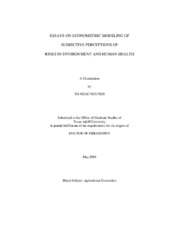| dc.description.abstract | A large body of literature studies the issues of the option price and other ex-ante
welfare measures under the microeconomic theory to valuate reductions of risks inherent
in environment and human health. However, it does not offer a careful discussion of how
to estimate risk reduction values using data, especially the modeling and estimating
individual perceptions of risks present in the econometric models. The central theme of
my dissertation is the approaches taken for the empirical estimation of probabilistic risks
under alternative assumptions about individual perceptions of risk involved: the
objective probability, the Savage subjective probability, and the subjective distributions
of probability. Each of these three types of risk specifications is covered in one of the
three essays.
The first essay addresses the problem of empirical estimation of individual
willingness to pay for recreation access to public land under uncertainty. In this essay I
developed an econometric model and applied it to the case of lottery-rationed hunting
permits. The empirical result finds that the model correctly predicts the responses of
84% of the respondents in the Maine moose hunting survey.
The second essay addresses the estimation of a logit model for individual binary
choices that involve heterogeneity in subjective probabilities. For this problem, I
introduce the use of the hierarchical Bayes to estimate, among others, the parameters of
distribution of subjective probabilities. The Monte Carlo study finds the estimator
asymptotically unbiased and efficient. The third essay addresses the problem of modeling perceived mortality risks
from arsenic concentrations in drinking water. I estimated a formal model that allows for
ambiguity about risk. The empirical findings revealed that perceived risk was positively
associated with exposure levels and also related individuating factors, in particular
smoking habits and one’s current health status. Further evidence was found that the
variance of the perceived risk distribution is non-zero.
In all, the three essays contribute methodological approaches and provide
empirical examples for developing empirical models and estimating value of risk
reductions in environment and human health, given the assumption about the
individual’s perceptions of risk, and accordingly, the reasonable specifications of risks
involved in the models. | en |


